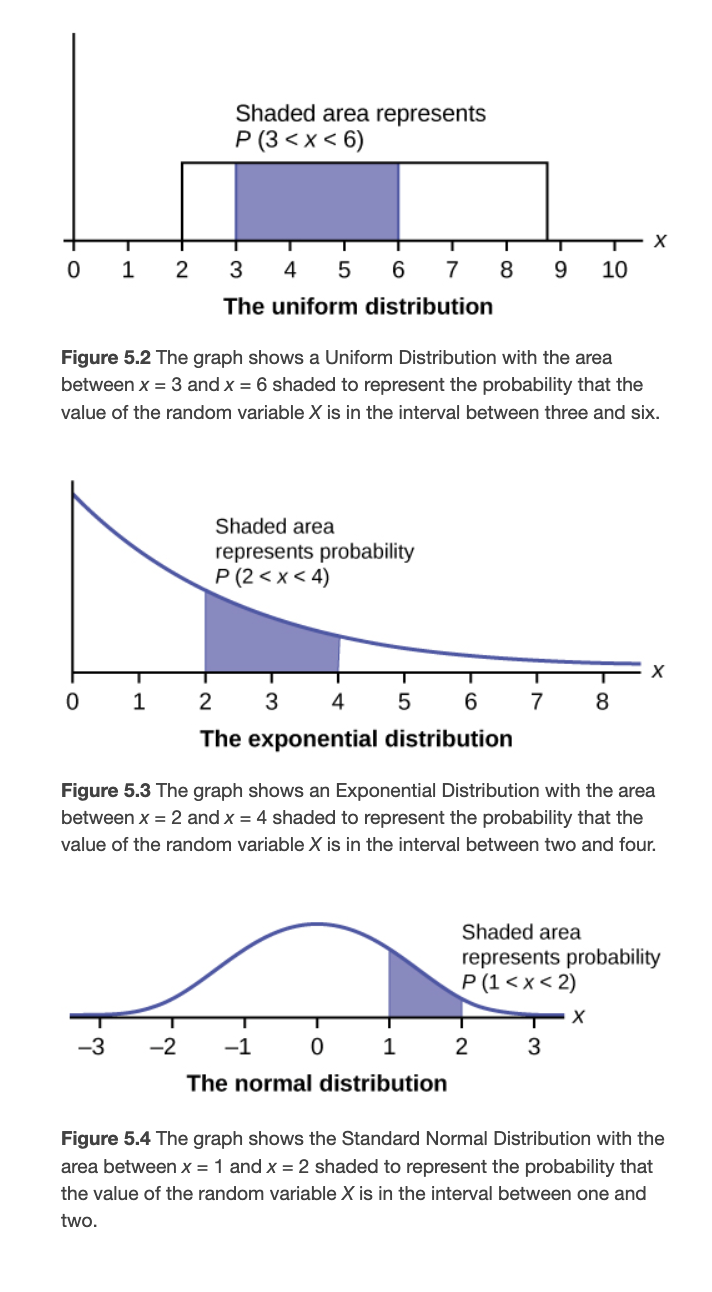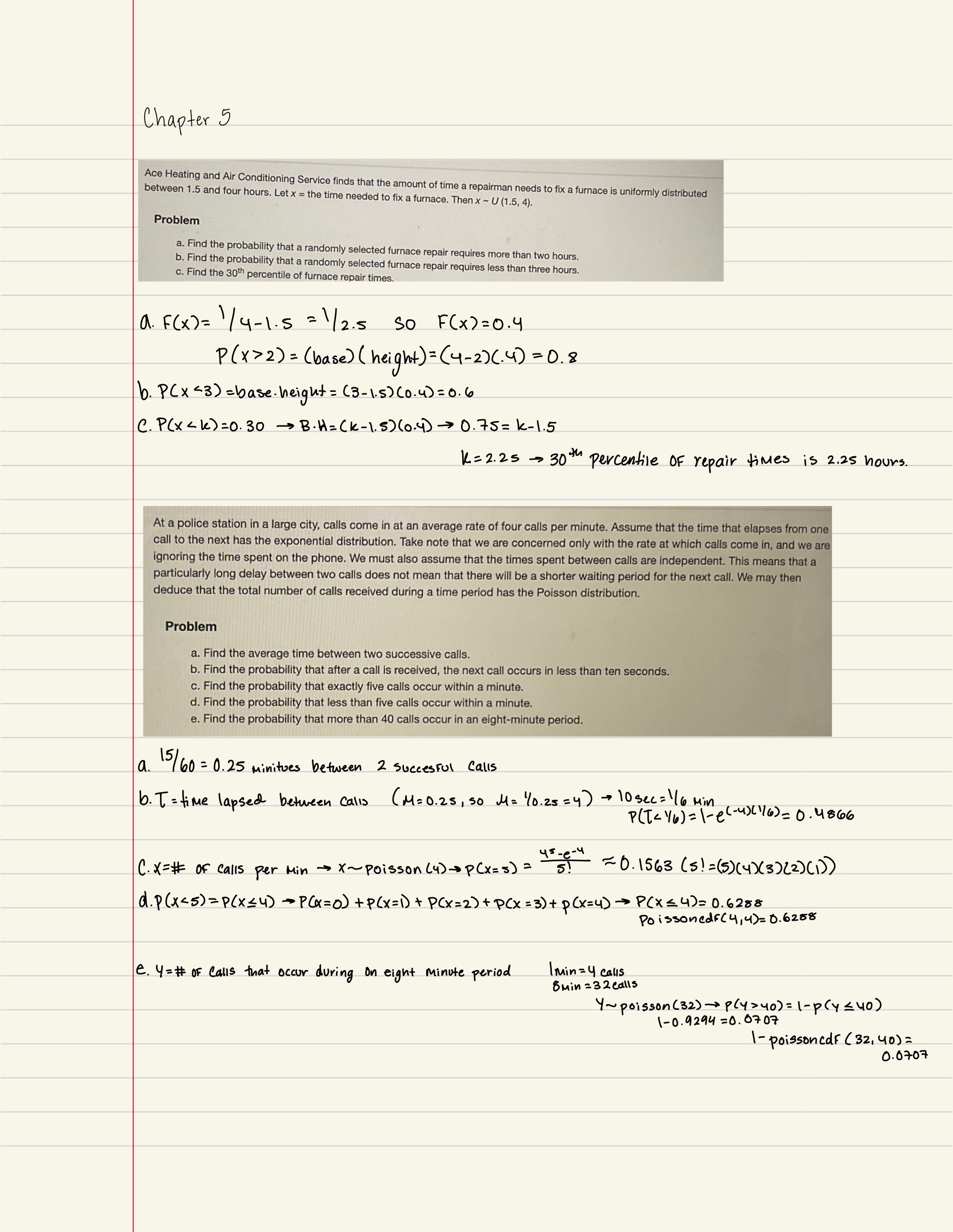
Chapter 5: Continuous Random Variables
Introduction
Properties of Continuous Probability Distributions
Probability density function: a statistical measure used to gauge the likely outcome of a discrete value
f(x) ≥ 0
The total area under the curve f(x) is one.

Cumulative distribution function: a function whose value is the probability that a corresponding continuous random variable has a value less than or equal to the argument of the function.
P(X ≤ x) = (𝑥−𝑎)/(𝑏−𝑎)

5.1 Continuous Probability Functions
Continuous probability distributions: PROBABILITY = AREA
Continuous probability density function: gives the relative likelihood of any outcome in a continuum occurring
𝑓(𝑥)=1 / 𝑏−𝑎 for a ≤ x ≤ b
5.2 The Uniform Distribution
The uniform distribution: is a continuous probability distribution and is concerned with events that are equally likely to occur.
Uniform Mean: 𝜇=(𝑎+𝑏) / 2
Uniform Standard deviation: 𝜎=√((𝑏−𝑎)^2 / 12)
Uniform pdf: 𝑓(𝑥)=1 / 𝑏−𝑎 for a ≤ x ≤ b
Uniform cdf: P(X ≤ x) = 𝑥−𝑎 / 𝑏−𝑎
X = a real number between a and b (in some instances, X can take on the values a and b). a = smallest X; b = largest X
Probability density function: 𝑓(𝑥)=(1 / b−a) for 𝑎 ≤ 𝑋 ≤ 𝑏
Area to the Left of x**:** P(X < x) = (x – a)(1 / 𝑏−𝑎)
Area to the Right of x**:** P(X > x) = (b – x)(1 / 𝑏−𝑎)
Area Between c and d**:** P(c < x < d) = (base)(height) = (d – c)(1 / 𝑏−𝑎)
5.3 The Exponential Distribution
Memoryless property: the independence of events or, more specifically, the independence of event-to-event times or P (X > r + t | X > r) = P (X > t) for all r ≥ 0 and t ≥ 0
Exponential Distribution: X ~ Exp(m) where m = the decay parameter
decay parameter: m = 1 / μ and we write X ∼ Exp(m) where x ≥ 0 and m > 0
exponential pdf: f(x) = me^(–mx) where x ≥ 0 and m > 0
exponential cdf: P(X ≤ x) = 1 – e^(–mx)
exponential mean: µ = 1/𝑚
exponential standard deviation: σ = µ
exponential percentile k: k = 𝑙𝑛(1−𝐴𝑟𝑒𝑎𝑇𝑜𝑇ℎ𝑒𝐿𝑒𝑓𝑡𝑂𝑓𝑘) / (−𝑚)
Additionally
P(X > x) = e^(–mx)
P(a < X < b) = e^(–ma) – e^(–mb)
Poisson probability: 𝑃(𝑋=𝑘)=𝜆^𝑘 𝑒^−𝑘 / 𝑘! P(X=k) with mean λ
k**!** = k*(k-1)*(k-2)*(k-3)*…3*2*1
Examples

Chapter 5: Continuous Random Variables
Introduction
Properties of Continuous Probability Distributions
Probability density function: a statistical measure used to gauge the likely outcome of a discrete value
f(x) ≥ 0
The total area under the curve f(x) is one.

Cumulative distribution function: a function whose value is the probability that a corresponding continuous random variable has a value less than or equal to the argument of the function.
P(X ≤ x) = (𝑥−𝑎)/(𝑏−𝑎)

5.1 Continuous Probability Functions
Continuous probability distributions: PROBABILITY = AREA
Continuous probability density function: gives the relative likelihood of any outcome in a continuum occurring
𝑓(𝑥)=1 / 𝑏−𝑎 for a ≤ x ≤ b
5.2 The Uniform Distribution
The uniform distribution: is a continuous probability distribution and is concerned with events that are equally likely to occur.
Uniform Mean: 𝜇=(𝑎+𝑏) / 2
Uniform Standard deviation: 𝜎=√((𝑏−𝑎)^2 / 12)
Uniform pdf: 𝑓(𝑥)=1 / 𝑏−𝑎 for a ≤ x ≤ b
Uniform cdf: P(X ≤ x) = 𝑥−𝑎 / 𝑏−𝑎
X = a real number between a and b (in some instances, X can take on the values a and b). a = smallest X; b = largest X
Probability density function: 𝑓(𝑥)=(1 / b−a) for 𝑎 ≤ 𝑋 ≤ 𝑏
Area to the Left of x**:** P(X < x) = (x – a)(1 / 𝑏−𝑎)
Area to the Right of x**:** P(X > x) = (b – x)(1 / 𝑏−𝑎)
Area Between c and d**:** P(c < x < d) = (base)(height) = (d – c)(1 / 𝑏−𝑎)
5.3 The Exponential Distribution
Memoryless property: the independence of events or, more specifically, the independence of event-to-event times or P (X > r + t | X > r) = P (X > t) for all r ≥ 0 and t ≥ 0
Exponential Distribution: X ~ Exp(m) where m = the decay parameter
decay parameter: m = 1 / μ and we write X ∼ Exp(m) where x ≥ 0 and m > 0
exponential pdf: f(x) = me^(–mx) where x ≥ 0 and m > 0
exponential cdf: P(X ≤ x) = 1 – e^(–mx)
exponential mean: µ = 1/𝑚
exponential standard deviation: σ = µ
exponential percentile k: k = 𝑙𝑛(1−𝐴𝑟𝑒𝑎𝑇𝑜𝑇ℎ𝑒𝐿𝑒𝑓𝑡𝑂𝑓𝑘) / (−𝑚)
Additionally
P(X > x) = e^(–mx)
P(a < X < b) = e^(–ma) – e^(–mb)
Poisson probability: 𝑃(𝑋=𝑘)=𝜆^𝑘 𝑒^−𝑘 / 𝑘! P(X=k) with mean λ
k**!** = k*(k-1)*(k-2)*(k-3)*…3*2*1
Examples

 Knowt
Knowt
